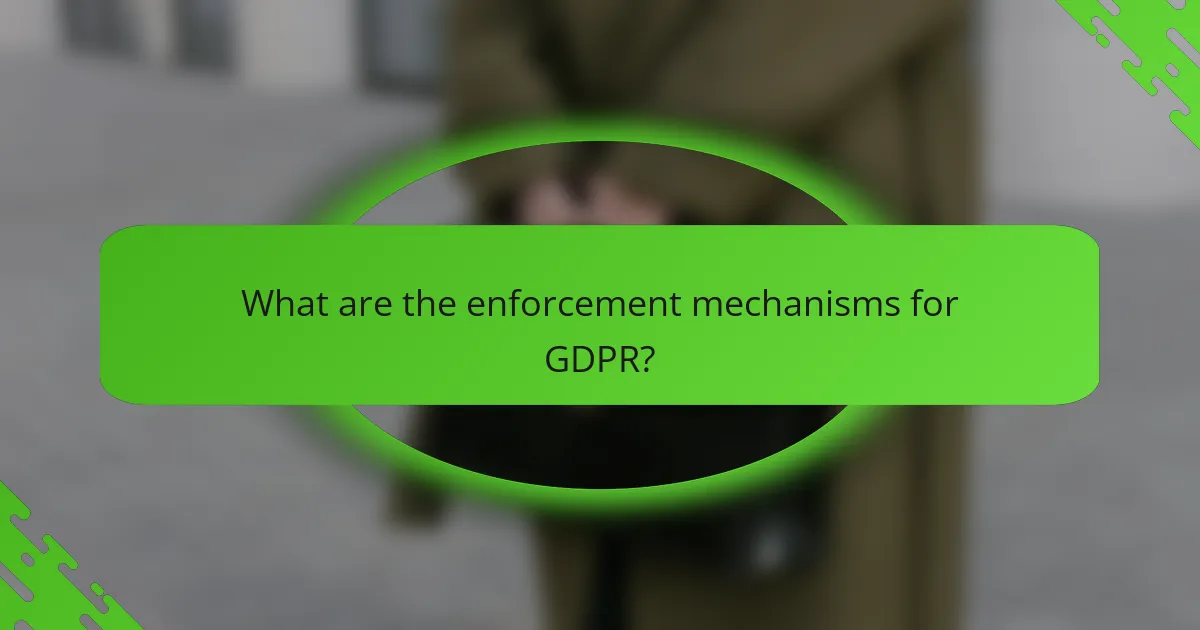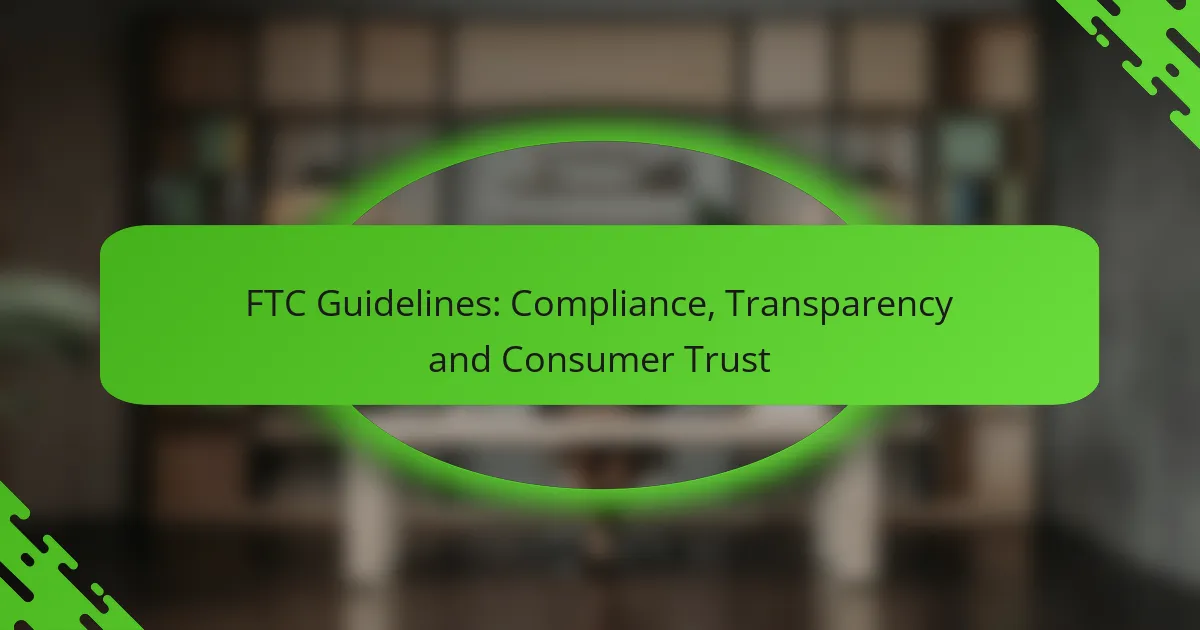The General Data Protection Regulation (GDPR) establishes key principles aimed at safeguarding personal data and upholding individuals’ rights. Organizations are required to adopt comprehensive measures that ensure transparency and responsible data handling, while individuals are granted rights such as data access, correction, deletion, and transfer. Compliance with GDPR not only protects consumer privacy but also helps businesses avoid significant penalties.

What are the key principles of GDPR compliance?
The key principles of GDPR compliance revolve around protecting personal data and ensuring individuals’ rights are respected. Organizations must implement measures that prioritize data protection throughout their operations and maintain transparency in their data handling practices.
Data protection by design
Data protection by design requires organizations to integrate data protection measures into their processes from the outset. This means considering privacy and security at every stage of product development and service delivery. For example, when creating a new application, developers should embed encryption and access controls to safeguard user data.
To effectively apply this principle, organizations can conduct privacy impact assessments (PIAs) to identify potential risks and implement necessary safeguards early in the design phase.
Data protection by default
Data protection by default mandates that organizations automatically apply the highest level of privacy settings to personal data unless users opt for less protection. This principle ensures that individuals’ data is only processed when necessary and that their privacy is prioritized. For instance, a social media platform should set user profiles to private by default.
Organizations should regularly review their default settings and practices to ensure they align with this principle and adjust them as needed to enhance user privacy.
Accountability and compliance
Accountability and compliance require organizations to demonstrate their adherence to GDPR principles through documentation and proactive measures. This includes maintaining records of data processing activities and implementing policies that promote data protection. Regular audits can help organizations assess their compliance status.
Organizations should appoint a Data Protection Officer (DPO) to oversee compliance efforts and serve as a point of contact for individuals seeking information about their data rights.
Transparency and communication
Transparency and communication involve informing individuals about how their personal data is collected, used, and stored. Organizations must provide clear and accessible privacy notices that outline their data processing activities. For example, a company should explain its data retention policies and the purposes for which data is processed.
Engaging with users through regular updates and clear communication channels can enhance trust and ensure individuals feel informed about their data rights.
Purpose limitation
Purpose limitation stipulates that personal data should only be collected for specific, legitimate purposes and not processed in a manner incompatible with those purposes. Organizations must clearly define the reasons for data collection and ensure that any further processing aligns with those reasons. For instance, data collected for customer service should not be used for marketing without explicit consent.
To comply with this principle, organizations should regularly review their data processing activities and ensure they remain aligned with the original purposes stated to users.

How can businesses ensure GDPR compliance?
Businesses can ensure GDPR compliance by implementing a structured approach that includes data audits, privacy policies, and staff training. These steps help organizations manage personal data responsibly and avoid potential fines.
Conducting data audits
Data audits involve systematically reviewing the personal data your business collects, processes, and stores. This process helps identify what data is held, where it is located, and how it is used, ensuring that all data handling practices align with GDPR requirements.
To conduct a data audit, start by creating an inventory of all personal data assets. Regularly update this inventory to reflect changes in data processing activities. Consider using a checklist to ensure all aspects of data collection and processing are covered.
Implementing privacy policies
Implementing clear privacy policies is essential for GDPR compliance. These policies should outline how personal data is collected, used, and protected, as well as the rights of individuals regarding their data.
Ensure that your privacy policy is easily accessible and written in plain language. Regularly review and update the policy to reflect any changes in data processing activities or legal requirements. Transparency builds trust with customers and helps avoid compliance issues.
Training staff on data protection
Training staff on data protection is crucial for maintaining GDPR compliance. Employees should understand their roles in safeguarding personal data and the importance of adhering to privacy policies.
Consider conducting regular training sessions that cover key GDPR principles, data handling procedures, and the consequences of non-compliance. Use practical examples to illustrate potential risks and encourage a culture of data protection within the organization.

What rights do individuals have under GDPR?
Under the General Data Protection Regulation (GDPR), individuals have several rights that empower them to control their personal data. These rights include access to their data, the ability to correct inaccuracies, the option to request deletion, and the capacity to transfer their data to other services.
Right to access
The right to access allows individuals to obtain confirmation from organizations about whether their personal data is being processed. If so, individuals can request a copy of their data along with information about the processing purposes, categories of data, and recipients.
Organizations must respond to access requests within one month, although this period can be extended in complex cases. It is advisable for individuals to submit requests in writing and specify the data they wish to access.
Right to rectification
The right to rectification enables individuals to request corrections to their personal data if it is inaccurate or incomplete. Organizations are obligated to rectify the data without undue delay upon receiving a valid request.
Individuals should provide sufficient detail about the inaccuracies and may need to supply evidence to support their claims. This right ensures that personal data remains accurate and up-to-date, which is crucial for effective data processing.
Right to erasure
Commonly known as the “right to be forgotten,” the right to erasure allows individuals to request the deletion of their personal data under certain conditions. This includes situations where the data is no longer necessary for the purposes for which it was collected or if consent is withdrawn.
Organizations must evaluate the request and respond within one month, considering any legal obligations to retain data. Individuals should clearly state their reasons for requesting erasure to facilitate the process.
Right to data portability
The right to data portability gives individuals the ability to obtain their personal data in a structured, commonly used, and machine-readable format. This right allows individuals to transfer their data from one service provider to another without hindrance.
To exercise this right, individuals must ensure that their data is processed based on consent or a contract. Organizations must respond to portability requests within one month and may need to assist in transferring the data to the new provider.

What are the enforcement mechanisms for GDPR?
The enforcement mechanisms for GDPR include oversight by Data Protection Authorities (DPAs), financial penalties, and legal actions by individuals. These mechanisms ensure compliance with data protection regulations and provide avenues for addressing violations.
Role of Data Protection Authorities
Data Protection Authorities (DPAs) are independent public authorities responsible for monitoring and enforcing GDPR compliance. They have the power to investigate complaints, conduct audits, and impose sanctions on organizations that fail to protect personal data.
DPAs also provide guidance to businesses on compliance and can issue warnings or reprimands before taking more severe actions. Their role is crucial in maintaining public trust in data protection practices.
Fines and penalties
Under GDPR, organizations can face significant fines for non-compliance, which can reach up to 4% of their annual global turnover or €20 million, whichever is higher. The severity of the penalty depends on the nature of the violation and whether it was intentional or negligent.
In addition to fines, DPAs may impose corrective measures, such as requiring organizations to change their data handling practices. Businesses should regularly assess their compliance to avoid these costly penalties.
Legal actions by individuals
Individuals have the right to take legal action against organizations that violate their data protection rights under GDPR. This includes the ability to seek compensation for damages resulting from breaches of personal data.
Individuals can file complaints with DPAs or pursue civil lawsuits, which can lead to additional financial liabilities for organizations. It is essential for businesses to establish clear processes for handling data subject requests to mitigate potential legal risks.

What are the challenges of GDPR compliance in the UK?
GDPR compliance in the UK presents several challenges, including understanding complex regulations, managing data processing activities, and ensuring proper consent management. Organizations must navigate these intricacies while avoiding penalties and maintaining customer trust.
Understanding data processing activities
Data processing activities encompass the collection, storage, and use of personal data. Organizations must clearly identify what data they process, the purpose of processing, and the legal basis for doing so. Keeping detailed records of these activities is essential for compliance and accountability.
To effectively manage data processing, companies should conduct regular audits and maintain a data inventory. This helps in identifying potential risks and ensuring that all processing aligns with GDPR requirements. Consider using data mapping tools to visualize and track data flows.
Managing consent effectively
Obtaining and managing consent is a critical aspect of GDPR compliance. Organizations must ensure that consent is freely given, specific, informed, and unambiguous. This means providing clear information about how personal data will be used and allowing individuals to withdraw consent easily.
To manage consent effectively, implement a robust consent management system that tracks user preferences and provides options for users to modify their consent at any time. Regularly review consent practices to ensure they remain compliant with evolving regulations and user expectations.
Cross-border data transfers
Cross-border data transfers involve sending personal data outside the UK or the European Economic Area (EEA). GDPR imposes strict conditions on these transfers to ensure that data remains protected. Organizations must verify that the receiving country provides adequate data protection or implement appropriate safeguards.
To facilitate compliant cross-border transfers, consider using Standard Contractual Clauses (SCCs) or Binding Corporate Rules (BCRs). Regularly assess the legal landscape of the destination country to ensure ongoing compliance with GDPR requirements. Avoid transferring data to countries without adequate protection measures in place.

How does GDPR impact marketing strategies?
GDPR significantly influences marketing strategies by imposing strict regulations on how personal data is collected, processed, and stored. Marketers must ensure compliance to avoid hefty fines and maintain customer trust.
Key Principles of GDPR
The key principles of GDPR include transparency, data minimization, purpose limitation, accuracy, storage limitation, integrity, and confidentiality. These principles require organizations to be clear about how they use personal data and to collect only what is necessary for specific purposes.
For example, businesses must inform customers about the data they collect and how it will be used. This can be achieved through clear privacy policies and consent forms that are easy to understand.
Rights of Individuals Under GDPR
Individuals have several rights under GDPR, including the right to access their data, the right to rectification, the right to erasure, and the right to data portability. These rights empower consumers to control their personal information and how it is used by businesses.
Marketers should implement processes to facilitate these rights, such as allowing customers to easily request access to their data or delete their information. This not only ensures compliance but also enhances customer relationships.
Enforcement of GDPR
GDPR enforcement is carried out by data protection authorities in each EU member state, which have the power to impose fines for non-compliance. Fines can reach up to 4% of a company’s global annual revenue or €20 million, whichever is higher.
To avoid penalties, businesses should conduct regular audits of their data practices, train employees on GDPR compliance, and establish clear data protection policies. Proactive measures can help mitigate risks and ensure adherence to regulations.










